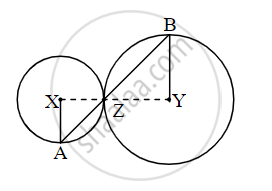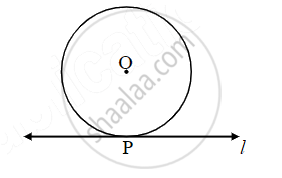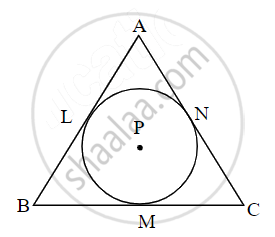Advertisements
Advertisements
Question
In the adjoining figure circles with centres X and Y touch each other at point Z. A secant passing through Z intersects the circles at points A and B respectively. Prove that, radius XA || radius YB. Fill in the blanks and complete the proof.

Construction: Draw segments XZ and YZ.
Proof:
By theorem of touching circles, points X, Z, Y are `square`.
∴ ∠XZA ≅ `square` ...(opposite angles)
Let ∠XZA = ∠BZY = a ...(I)
Now, seg XA ≅ seg XZ ...[Radii of the same circle]
∴∠XAZ = `square` = a ...[isosceles triangle theorem](II)
Similarly,
seg YB ≅ seg YZ ...[Radii of the same circle]
∴∠BZY = `square` = a ...[isosceles triangle theorem](III)
∴ from (I), (II), (III),
∠XAZ = `square`
∴ radius XA || radius YZ ...[`square`]
Solution
Construction: Draw segments XZ and YZ.
Proof:
By theorem of touching circles, points X, Z, Y are collinear.
∴ ∠XZA ≅ ∠BZY ...(opposite angles)
Let ∠XZA = ∠BZY = a .....(I)
Now, seg XA ≅ seg XZ ...[Radii of the same circle]
∴∠XAZ = ∠XZA = a ....[isosceles triangle theorem](II)
Similarly, seg YB ≅ seg YZ ....[Radii of the same circle]
∴∠BZY = ∠ZBY = a ...[isosceles triangle theorem](III)
∴ from (I), (II), (III),
∠XAZ = ∠ZBY
∴ radius XA || radius YB ...[Alternate angle test]
RELATED QUESTIONS
If two circles with radii 5 cm and 3 cm respectively touch internally, find the distance between their centres.
Two circles having radii 3.5 cm and 4.8 cm touch each other internally. Find the distance between their centres.
If radii of two circles are 4 cm and 2.8 cm. Draw a figure of this circles touching each other externally.
In the given figure, the circles with centres P and Q touch each other at R. A line passing through R meets the circles at A and B respectively. Prove that – (1) seg AP || seg BQ,
(2) ∆APR ~ ∆RQB, and
(3) Find ∠ RQB if ∠ PAR = 35°
In the given figure, ray PQ touches the circle at point Q. PQ = 12, PR = 8, find PS and RS.
Four alternative answers for the following question is given. Choose the correct alternative.
Two circles of radii 5.5 cm and 3.3 cm respectively touch each other. What is the distance between their centers ?
Four alternative answers for the following question is given. Choose the correct alternative.
Two circles intersect each other such that each circle passes through the centre of the other. If the distance between their centres is 12, what is the radius of each circle?
Line l touches a circle with centre O at point P. If radius of the circle is 9 cm, answer the following.
- What is d(O, P) = ? Why?
- If d(O, Q) = 8 cm, where does the point Q lie?
- If d(O, Q) = 15 cm, How many locations of point Q are line on line l? At what distance will each of them be from point P?

Draw circles with centres A, B and C each of radius 3 cm, such that each circle touches the other two circles.
In the given figure, circles with centres C and D touch internally at point E. D lies on the inner circle. Chord EB of the outer circle intersects inner circle at point A. Prove that, seg EA ≅ seg AB.

If two circles with diameters 8 cm and 6 cm respectively touch externally, find the distance between their centers.
Four alternative answers for the following question is given. Choose the correct alternative.
Two circles having diameters 8 cm and 6 cm touch each other internally. Find the distance between their centres.
Line ℓ touches a circle with centre O at point P. If radius of the circle is 9 cm, answer the following.

What is d(O, P) =? Why?
Line ℓ touches a circle with centre O at point P. If radius of the circle is 9 cm, answer the following.

If d(O, R) = 15 cm, how many locations of point R are line on line l? At what distance will each of them be from point P?
A circle with centre P is inscribed in the ∆ABC. Side AB, side BC, and side AC touch the circle at points L, M, and N respectively. The radius of the circle is r.

Prove that: A(ΔABC) = `1/2` (AB + BC + AC) × r
Two circles of radii 5.5 cm and 4.2 cm touch each other externally. Find the distance between their centres.
